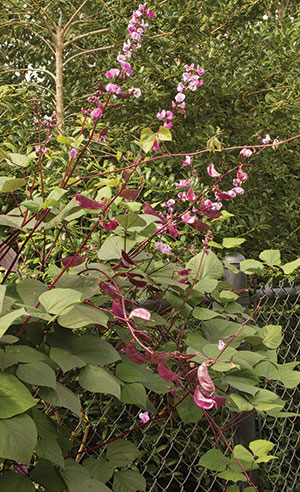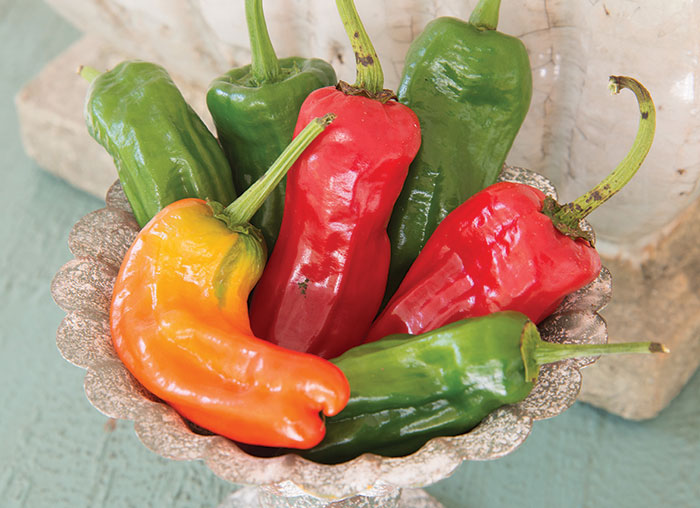Hot peppers have been the darlings of both vegetable and ornamental gardeners in recent years because they can be so colorful, so sizzling, so sexy, especially when compared to sweet peppers, of which the ol’ utilitarian, blocky bell pepper usually comes to mind. Ho-hum.
Granted, the common bell pepper can have the eye-catching appeal of brown shoes with a black suit, but, psssst! Ya wanna know a secret? There really are sweet peppers that not only have great taste — and way, way less heat — but also the visual sass that can equally compete with the fanciest hot peppers in the garden.
Below are four such floosies to consider not only for your veggie patch but even flower border or container planters this year:
Carmen. An All-America Selections winner, this cultivar shows off 6-inch, elongated peppers that mature from green to a handsome red — creating, for those so inclined to wish, a touch of summertime Christmas in the garden. And not only is ‘Carmen’ a prolific fruit producer, but it is resistant to many common diseases that can plague other peppers. Easy to enjoy raw, this selection is also a pleasant culinary experience waiting to happen when roasted.
Shishito. Another contender to create a “Yuletide July” effect in the garden, this old heirloom variety also sports green peppers that eventually color shift to a bright red. And like ‘Carmen’, the 3- to 4-inch fruits are a treat to eat roasted. In addition, showing their Oriental origin, these thin-walled peppers are a popular ingredient in stir-fries and tempura. Definitely delicious, this sweet pepper is not a stranger to chefs at fine restaurants.
If you want to explore the possibilities of both sweet and hot peppers in the garden even further, check out these online sites for the seeds of many unique varieties:
- The Pepper Gal, Ft. Lauderdale, Fla.; peppergal.com
- Pepper Joe’s, Myrtle Beach, S.C.; pepperjoe.com
- Chile Pepper Institute, Las Cruces, N.M.; cpi.nmsu.edu
Sweet Banana. As advertised, this is a variety with mild tasting fruit that dangle from branches like miniature, 6-inch-long bananas. Yellow, of course, is the color of a banana, which is the hue of these peppers when they first develop, but then their color changes to warm orange and finally a striking crimson, making for a very pretty plant. In the kitchen, ‘Sweet Banana’ is a tasty addition to salads, sandwiches or stir-fries, and is a favorite pick of pepper picklers.
Cubanelle. Green, chartreuse, orange, red — similar to the visual pop of ‘Sweet Banana,’ this is the delightful tapestry of colors ‘Cubanelle’ can bring to any garden scheme. Usually harvested when immature green for the mildest taste, the 4- to 6-inch-long, elongated, crinkly fruits have thin skins, which makes them good candidates for frying and roasting, but sandwiches and salads can also be perked up with the addition of raw slices of this pepper. Home cooks in the know often bypass ordinary bell peppers at grocery stores when ‘Cubanelle’ is also offered.
Although not as common as bell pepper plants, these four sweet selections really aren’t hard to find — I bought all of them at local big box garden centers last spring. Dedicated nurseries, as well as the State Farmers Market in Raleigh, probably offer some if not all of these peppers.

Have an ugly wire fence? Want a summertime privacy screen? Do the rails on your deck need dressing up?
If your answer is “Yes” to any of these questions, the solution might be found at your friendly local garden center.
Now is a good time to plant any of the many fast-growing, flowering annual vines such as moonvine, mandevilla, morning glory, black-eyed Susan vine, cardinal climber, scarlet runner bean, firecracker vine, cypress vine or purple hyacinth bean.
All of these vines can be grown from seed, but for quicker coverage, consider buying young plants at nurseries, if they are available.
To Do in the Garden
May
- Besides peppers, continue planting other summer veggies such as pole beans, sweet potatoes, tomatoes, squash, pumpkins, eggplant, cucumbers, okra, watermelons and lima beans.
- Now that spring-blooming annuals and bulbs are past their prime, replant flower beds with colorful annual heat-seekers such as portulaca, celosia, sun coleus, petunias, salvias, marigolds and zinnias.
- Have little time to deadhead blossoms to stimulate more flower production? Consider including continuous blooming plants such as alyssum, impatiens, ageratum, cleome, scabiosa, lobelia and vinca that don’t need constant visits from the “flower police.”
- Worried about indoor pollutants? Spider plant, aloe vera, philodendron and golden pothos are efficient at helping to clear the air in offices and homes of unhealthy chemical compounds.
- Before the summer begins to sizzle, mulch around new plantings to reduce wild fluctuations in soil temperature and moisture content.
- A great weed block to combine with organic mulches is a layer of three to four pages of newspaper. Put on the ground first and then covered with mulch, this paper barrier will prevent most weeds for at least one growing season before decomposing.
- Since black spot on roses is a soil-borne disease, installing a drip irrigation system or using a soaker hose in the planting bed will help prevent its occurrence and spread.
- Don’t forget to clean the birdbath and refill it with fresh water every week.







